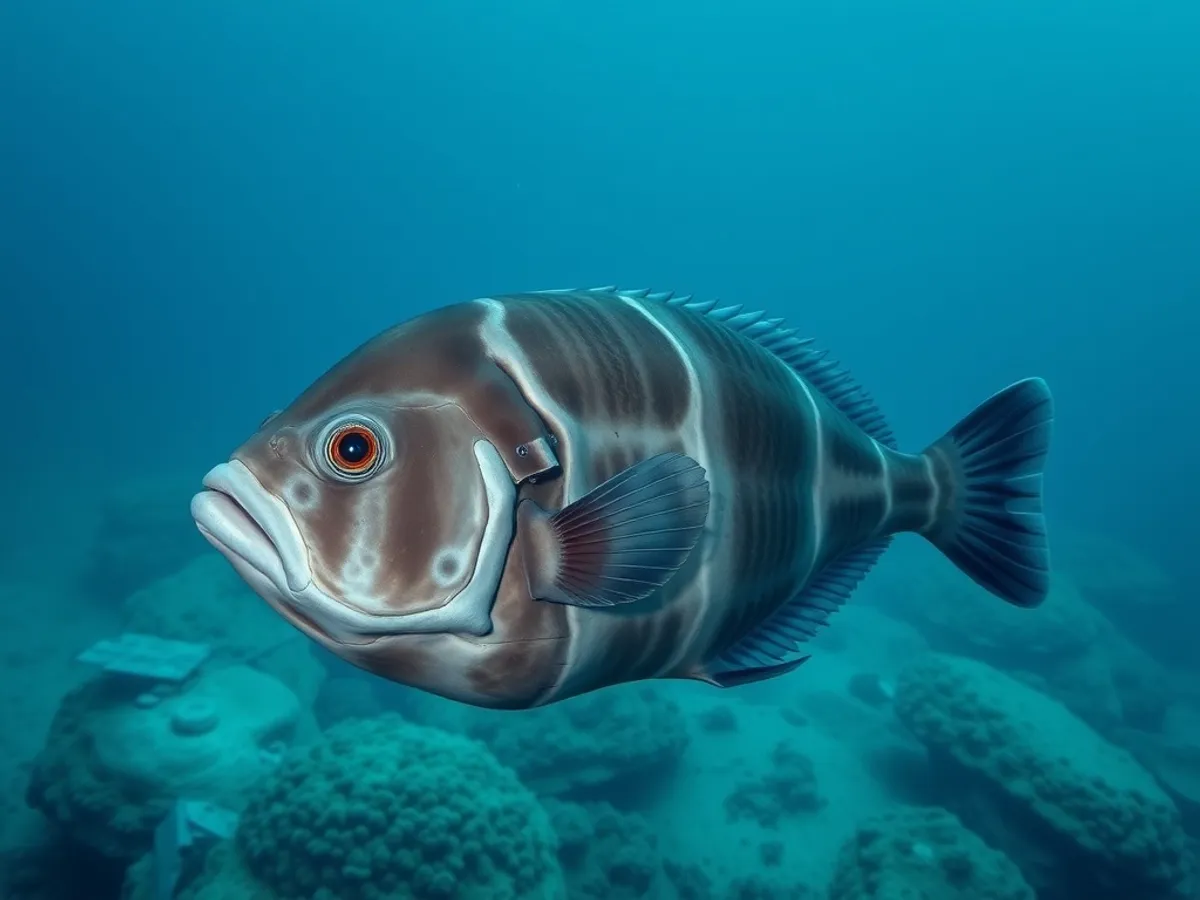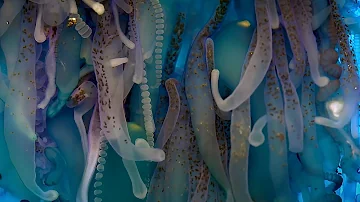
Oceanic Moonfish
Lampris guttatus

Meet the Oceanic Moonfish
The Oceanic Moonfish, also known as the Opah, is a large, deep-bodied pelagic fish recognized for its striking, disc-shaped body and vibrant coloration. Its scales shimmer with silvery-blue and orange-red hues, and it can reach impressive sizes, making it one of the most visually distinctive fish in the world's oceans. Moonfish inhabit deep, open waters and are known for their unusual ability to regulate their body temperature, a rare trait among fish. They are powerful swimmers, often found at depths ranging from 50 to 500 meters. Their unique biology and appearance make them a fascinating subject for marine researchers.
Classification
Fish
Habitat
Open ocean (pelagic zone)
Diet
Carnivore
Lifespan
8-12 years
Conservation
Least Concern
Weight
50–270 kg (110–595 lbs)
📖Fascinating Facts
Deep Sea Swimmer
Moonfish are typically found at depths between 50 and 500 meters, making them true inhabitants of the open ocean's midwater zone.
Warm-blooded Fish
Unlike most fish, the Moonfish can regulate its body temperature, maintaining warmth in its muscles and vital organs for improved performance.
Bycatch Species
Moonfish are not usually targeted by fisheries but are frequently caught as bycatch in longline and drift gillnet fisheries.
📋Detailed Description
The Oceanic Moonfish (Lampris guttatus), commonly known as the Opah, is a large, laterally compressed pelagic fish that can reach lengths of up to 2 meters and weigh over 270 kilograms. Its body is almost circular in profile, with a deep chest and a narrow, crescent-shaped tail fin. The Opah's scales are metallic silvery-blue with distinctive orange to vermilion fins and spots, and its large eyes are rimmed with gold. Unlike most fish, the Opah is endothermic, capable of elevating its body temperature above that of the surrounding water by as much as 5°C, thanks to a unique counter-current heat exchange system in its gills. This adaptation allows it to maintain high levels of activity and efficient predation in cold, deep waters. Anatomically, it possesses long, falcate pectoral fins and a small, terminal mouth lined with fine, brush-like teeth suited for capturing small prey. The Opah's musculature is robust, supporting powerful, continuous swimming. It is a solitary species, rarely observed in groups, and is most active at mesopelagic depths between 50 and 500 meters, though it has been recorded as deep as 1,000 meters. The species exhibits diel vertical migration, moving closer to the surface at night to feed. Its internal organs, especially the heart and swimming muscles, are insulated and supplied with warm blood, supporting sustained aerobic activity in cold environments.
💡 Did you know?
The Opah can elevate its body temperature up to 5°C (9°F) above the surrounding water, allowing it to hunt more effectively in cold, deep waters.
🔬Research & Sources
🎭Behavior & Social Structure
Lampris guttatus is primarily solitary, with individuals occupying large home ranges in the open ocean. It is an active predator, employing a combination of visual hunting and rapid bursts of speed to capture prey such as small fish (e.g., myctophids), squid, and crustaceans. The Opah uses its large pectoral fins for continuous, flapping locomotion, which is unusual among pelagic fishes that typically rely on body undulations. This swimming style, combined with endothermy, allows for sustained activity and agility. Feeding typically occurs during nocturnal ascents to shallower waters, following the vertical migration of prey. There is little evidence of complex social interactions or schooling behavior; encounters between individuals are rare. The Opah is known to be a deep-water forager, often exploiting prey resources that are inaccessible to many other large pelagic predators. Daily routines are closely linked to prey availability and environmental conditions, with some evidence of seasonal shifts in depth distribution.
👶Reproduction & Life Cycle
Reproductive biology in Lampris guttatus is not fully understood due to the species' deep-sea habits, but it is known to be oviparous, releasing large numbers of pelagic eggs into the water column. Spawning is believed to occur in warmer waters, with peak breeding seasons varying by hemisphere—typically spring and summer in the Northern Hemisphere. Females are highly fecund, producing hundreds of thousands to millions of eggs per spawning event. Fertilization is external, and there is no parental care; eggs and larvae are left to develop independently in the plankton. Larvae are pelagic and undergo significant morphological changes as they mature, including the development of characteristic body shape and coloration. Growth rates are rapid in early life stages, but little is known about juvenile survival rates or recruitment patterns.
🛡️Adaptations & Survival
The most notable adaptation of the Oceanic Moonfish is its whole-body endothermy, a rare trait among fish. This is achieved through a specialized rete mirabile in the gills, which conserves metabolic heat generated by continuous pectoral fin movement. This adaptation allows the Opah to maintain muscle and organ temperatures above ambient water, enhancing swimming performance, visual acuity, and predatory efficiency in cold, deep environments. Its large, falcate pectoral fins enable efficient, high-speed cruising, while its streamlined body reduces drag. The Opah's large eyes are adapted for low-light vision, aiding in the detection of prey at depth. Its diet is opportunistic, with a flexible jaw and fine teeth suited for capturing a variety of small, agile prey. The silvery, reflective scales provide camouflage in the open ocean, reducing visibility to both predators and prey.
📚Research Sources
🎨Cultural Significance
The Opah has limited cultural significance compared to more iconic marine species, but it is prized as a delicacy in some regions, particularly in Hawaii and parts of Asia, where its flesh is valued for its flavor and texture. In ancient Mediterranean cultures, the Opah was sometimes associated with good luck and was occasionally depicted in art. Its striking appearance and rarity in markets have led to its occasional use as a symbol of exoticism and abundance. There are no known mythological or widespread symbolic associations, but its unusual biology has made it a subject of interest in popular science and marine education.
🔬Recent Research & Discoveries
Recent research has focused on the Opah's unique endothermic physiology, with a landmark 2015 study (Wegner et al., Science) documenting the first evidence of whole-body endothermy in a fish. Ongoing studies are investigating its migratory patterns using satellite tagging, revealing complex vertical and horizontal movements linked to oceanographic features and prey availability. Genetic analyses are clarifying population structure and connectivity across ocean basins. There is also interest in the Opah's role in pelagic food webs, particularly as a mid-level predator influencing the abundance of mesopelagic prey. The species' resilience to fishing pressure and environmental change is an area of active research, with implications for deep-sea fisheries management.
🎥Wildlife Videos

The Depths of the North Sea: Life in the Cold Abyss | Secrets of the Seas Ep. 1 | 4K UHD Documentary
"Seas in Motion - Wonders of the North Sea" unveils the dynamic ecosystem of one of Europe's most vital bodies of water.
space and science

Oceans Odysseys: Incredible Animal Journeys (Full Episode) | National Geographic
Jump on board with the dedicated ocean moms risking it all to bring new life into the world. Enjoy a free trial of National ...
National Geographic

David Attenborough | Monterey Bay | Deep Ocean | Life in the Abyss
David Attenborough narrates this astonishing journey into the deep ocean. The NHK team that captured the world's first footage of ...
symmetry

Exploring The Underwater World | 4K UHD | Blue Planet II | BBC Earth
Travel to the depths of our mysterious oceans to discover all kinds of curious creatures underwater – from fish that communicate ...
BBC Earth

Our Oceans - Unlocking the Secrets of the Underwater | Free Documentary Nature
Adventure Ocean Quest - All Episodes | Ocean Documentary Watch 'Ocean Stories - Full Series' here: ...
Free Documentary - Nature

Stunning 4K Underwater Nature Footage | BBC Earth
Our oceans cover 71% of the planet, provide us with about half of our oxygen and are home to hundreds of thousands of known ...
BBC Earth
🌍Habitat Information
The Oceanic Moonfish typically inhabits Open ocean (pelagic zone) environments. Oceanic Moonfishs have adapted to their environments with specialized features and behaviors.
Primary Habitat:
Open ocean (pelagic zone)
More detailed habitat information will be available soon.
🛡️Conservation Status
The Oceanic Moonfish is currently classified as Least Concern. Conservation efforts are crucial for preserving this species for future generations.
Common Threats:
- 🏠Habitat loss and fragmentation
- 🌡️Climate change impacts
- 🎯Hunting and poaching
- 🏭Human-wildlife conflict
⚠️Threats & Conservation Challenges
Currently assessed as Least Concern by the IUCN, Lampris guttatus faces relatively few direct threats due to its wide distribution and deep-water habitat. However, incidental bycatch in pelagic longline and drift net fisheries, particularly those targeting tuna and swordfish, represents a significant source of mortality. There is limited data on population trends, but localized declines may occur in heavily fished regions. Climate change and ocean warming could alter prey distributions and impact reproductive success. The species is not a primary target for commercial fisheries, but its meat is occasionally marketed, particularly in Asia and the Mediterranean. Ongoing monitoring is needed to assess long-term population health and the impacts of deep-sea fishing practices.
🔬Scientific Classification
Scientific Name
Lampris guttatus
Classification Hierarchy
🔍 About Taxonomic Classification
Taxonomic classification is a hierarchical system used by scientists to classify and organize living organisms based on shared characteristics and evolutionary relationships.
The system moves from broad categories (Kingdom) to increasingly specific ones, with each animal's scientific name typically consisting of its Genus and species.
📝Community Notes
Share your observations and insights about the Oceanic Moonfish with our community of wildlife enthusiasts.
Join Our Community
Sign in to share your observations and connect with fellow wildlife enthusiasts.
Sign In to ContributeNo community notes yet
Be the first to share your observations about the Oceanic Moonfish!
Explore Oceanic Moonfish
Select a tab above to learn more about this amazing animal.
📸Photo Gallery
No photos available for this animal yet.
🌟Discover More Wildlife
Continue your journey of discovery with more fascinating animals from our database
